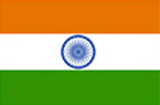
Nation Brief
Map of India

NationalFlag:

TheNational flag is a horizontal tricolour of deep saffron (Kesaria) atthe top, white in the middle and dark green at the bottom in equalproportion.
The ratio of width of the flag to itslength is two to three.
In the center of the whiteband is a navy-blue wheel which represents the Chakra. Its design isthat of the wheel which appears on the abacus of the Sarnath LionCapital of Ashoka. Its diameter approximates to the width of the whiteband and it has 24 spokes.
The design of thenational flag was adopted by the Constituent Assembly of India on 22ndJuly 1947. Its use and display are regulated by the Indian FlagCode.
StateEmblem:

Thestate emblem is an adaptation from the Sarnath Lion Capital ofAshoka.
In the original, there are four lions,standing back to back, mounted on an abacus with a frieze carryingsculptures in high relief of an elephant, a galloping horse, a bull anda lion separated by intervening wheels over a bell-shapedlotus.
Carved out of a single block of polishedsandstone, the capital is crowned by the Wheel of the Law (DharmaChakra).
In the State emblem, adopted by theGovernment of India on 26 January 1950, only three lions are visible,the fourth being hidden from view. The wheel appears in relief in thecenter of the abacus with a bull on right and a horse on left and theoutlines of the wheels on extreme right and left. The bell-shaped lotushas been omitted. The words Satyameva Jayate from Mundaka Upanishad,meaning NTruth Alone TriumphsO, are inscribed below the abacus inDevanagariscript.
NationalAnthem:
The song Jana-gana-mana,composed originally in Bengali by Rabindranath Tagore, was adopted inits Hindi version by the Constituent Assembly as the National Anthem ofIndia on 24th January 1950.
It was first sung on27th December 1911 at the Calcutta Session of the Indian NationalCongress.
The complete song consists of fivestanzas. The first stanza contains the full version of the NationalAnthem :
Jana-gana-mana-adhinayaka, jayahe
Bharata-bhagya-vidhata.
Punjab-Sindh-Gujarat-Maratha
Dravida-Utkala-Banga
Vindhya-Himachala-Yamuna-Ganga
Uchchala-Jaladhi-taranga.
Tavashubha name jage,
Tava shubha asisamage,
Gahe tava jayagatha,
Jana-gana-mangala-dayaka jayahe
Bharata-bhagya-vidhata.
Jayahe, jaya he, jaya he,
Jaya jaya jaya, jaya he!
Playing time of the full version ofthe national anthem is approximately 52 seconds. A short versionconsisting of first and last lines of the stanza(playing timeapproximately 20 seconds) is also played on certain occasions. Thefollowing is Tagore's English rendering of the anthem:
Thou artthe ruler of the minds of all people,
dispenser ofIndia's destiny.
Thy name rouses the hearts ofPunjab, Sind,
Gujarat andMaratha,
Of the Dravida and Orissa andBengal;
It echoes in the hills of the Vindyas andHimalayas,
mingles in the music of Jamuna and Gangesand is
chanted by the waves of the IndianSea.
They pray for thy blessings and sing thypraise.
The saving of all people waits in thyhand,
thou dispenser of India'sdestiny.
Victory, victory, victory to thee.
National Song:
The song VandeMataram, composed in Sanskrit by Bankimchandra Chatterji, was a sourceof inspiration to the people in their struggle for freedom. It has anequal status with Jana-gana-mana.
The firstpolitical occasion when it was sung was the 1896 session of the IndianNational Congress.
The following is the text of itsfirst stanza:
VandeMataram!Sujalam, suphalam, malayajashitalam,
Shasyashyamalam,Mataram!
Shubhrajyothsnapulakitayaminim,
Phullakusumita drumadalashobhinim,
Suhasinim sumadhurabhashinim,
Sukhadam varadam,Mataram!
The English translation of thestanza rendered by Sri Aurobindo in prose is:
I bow tothee, Mother,
richly-watered,richly-fruited,
cool with the winds of thesouth,
dark with the crops of theharvests,
The Mother!
Her nightsrejoicing in the glory of the moonlight,
her landsclothed beautifully with her trees in floweringbloom,
sweet of laughter, sweet ofspeech,
The Mother, giver of boons, giver ofbliss.
NationalCalender:
The national calendar basedon the Saka Era with Chaitra as its first month and a normal year of365 days was adopted from 22 March 1957 along with the Gregoriancalendar for the following official purposes: (i) Gazette of India,(ii) news broadcast by All India Radio, (iii) calendars issued by theGovernment of India and (iv) Government communications addressed to themembers of the public.
Dates of the nationalcalendar have a permanent correspondence with dates of the Gregoriancalendar : 1 Chaitra falling on 22 March normally and on 21 March inleap year.
National Animal:

Themagnificent tiger, Panthera tigris (Linnaeus), is a striped animal. Ithas a thick yellow coat of fur with darkstripes.
The combination of grace, strength, agilityand enormous power has earned the tiger its pride of place as thenational animal of India.
Out of eight races of thespecies known, the Indian race, the Royal Bengal Tiger, is foundthroughout the country except in the north-western region and also inthe neighbouring countries, Nepal, Bhutan and Bangladesh. To check thedwindling population of tigers in India 'Project Tiger' was launched inApril 1973. So far, 27 tiger reserves have been established in thecountry under this project, covering an area of 37,761 sqkm.
NationalBird:

TheIndian peacock, Pavo cristatus (Linnaeus), the national bird of India,is a colourful, swan-sized bird, with a fan-shaped crest of feathers, awhite patch under the eye and a long, slender neck. The male of thespecies is more colourful than the female, with a glistening bluebreast and neck and a spectacular bronze-green train of around 200elongated feathers. The female is brownish, slightly smaller than themale, and lacks the train. The elaborate courtship dance of the male,fanning out the tail and preening its feathers, is a gorgeoussight.
The peacock is widely found in the Indiansub-continent from the south and east of the Indus river, Jammu andKashmir, east Assam, south Mizoram and the whole of the Indianpeninsula. The Peacock enjoys protection from the people as it is nevermolested for religious and sentimental reasons. It is fully protectedunder the Indian Wildlife (Protection) Act,1972.
National Flower:

Lotus(Nelumbo nucifera) is the National Flower of India. It is a sacredflower and occupies a unique position in the art and mythology ofancient India and has been an auspicious symbol of Indian culture sincetime immemorial.